Effect of a Roughness Element on the Receptivity of a Hypersonic Boundary Layer over a Blunt Cone Due to Pulse Entropy Disturbance with a Single Frequency
Abstract
:1. Introduction
2. Governing Equations and Numerical Methods
3. Calculation Model and Conditions
4. Results
4.1. Effect of the Roughness Element on the Hypersonic Flow Field
4.2. Effect of the Roughness Element on the Evolution of Disturbances in the Hypersonic Boundary Layer
5. Conclusions
Author Contributions
Acknowledgments
Conflicts of Interest
References
- Paredes, P.; Choudhari, M.M.; Li, F.; Jewell, J.S.; Kimmel, R.L.; Marineau, E.C.; Grossir, G. Nosetip bluntness effects on transition at hypersonic speeds: Experimental and numerical analysis under NATO STO AVT-240. In Proceedings of the 2018 AIAA Aerospace Sciences Meeting, Kissimmee, FL, USA, 8–12 January 2018; p. 0057. [Google Scholar] [CrossRef]
- Jewell, J.S.; Kimmel, R.L. Boundary Layer Stability Analysis for Stetson’s Mach 6 Blunt Cone Experiments. J. Spacecr. Rocket. 2017, 54, 258–265. [Google Scholar] [CrossRef]
- Tufts, M.W.; Kimmel, R.L. Analysis of Windward Side Hypersonic Boundary Layer Transition on Blunted Cones at Angle of Attack. In Proceedings of the 55th AIAA Aerospace Sciences Meeting, Grapevine, TX, USA, 9–13 January 2017; p. 0764. [Google Scholar] [CrossRef]
- Cook, D.A.; Thome, J.; Brock, J.M.; Nichols, J.W.; Candler, G.V. Understanding effects of nose-cone bluntness on hypersonic boundary layer transition using input-output analysis. In Proceedings of the 2018 AIAA Aerospace Sciences Meeting, Kissimmee, FL, USA, 8–12 January 2018; p. 0378. [Google Scholar] [CrossRef]
- Zhong, X.; Wang, X. Direct Numerical Simulation on the Receptivity, Instability, and Transition of Hypersonic Boundary Layers. Annu. Rev. Fluid Mech. 2012, 44, 527–561. [Google Scholar] [CrossRef]
- Balakumar, P.; King, R.A.; Chou, A.; Owens, L.R.; Kegerise, M.A. Receptivity and Forced Response to Acoustic Disturbances in High-Speed Boundary Layers. AIAA J. 2017, 65, 510–523. [Google Scholar] [CrossRef]
- Reed, H.L.; Saric, W.S. Linear Stability Theory Applied to Boundary Layers. Annu. Rev. Fluid Mech. 1996, 28, 389–428. [Google Scholar] [CrossRef]
- Laurence, S.J.; Wagner, A.; Hannemann, K. Experimental study of second-mode instability growth and breakdown in a hypersonic boundary layer using high-speed schlieren visualization. Annu. Rev. Fluid Mech. 2016, 797, 471–503. [Google Scholar] [CrossRef]
- Bippes, H. Basic experiments on transition in three-dimensional boundary layers dominated by crossflow instability. Prog. Aeronaut. Sci. 1999, 35, 363–412. [Google Scholar] [CrossRef]
- Saric, W.S.; Reed, H.L.; White, E.B. Stability and Transition of Three-Dimensional Boundary Layers. Annu. Rev. Fluid Mech. 2003, 35, 413–440. [Google Scholar] [CrossRef]
- Cerminara, A.; Sandham, N.D. Acoustic Leading-Edge Receptivity for Supersonic/Hypersonic Flows over a Blunt Wedge. AIAA J. 2017, 55, 4234–4244. [Google Scholar] [CrossRef]
- Chou, A.; Balakumar, P.; Schneider, S.P. Development of Instabilities Generated by Freestream Laser Perturbations in a Hypersonic Boundary Layer. AIAA J. 2017, 55, 1–9. [Google Scholar] [CrossRef]
- Qin, F.; Wu, X. Response and receptivity of the hypersonic boundary layer past a wedge to free-stream acoustic, vortical and entropy disturbances. J. Fluid Mech. 2016, 797, 874–915. [Google Scholar] [CrossRef]
- Wang, X.; Zhong, X.; Ma, Y. Response of a Hypersonic Boundary Layer to Wall Blowing-Suction. AIAA J. 2012, 49, 1336–1353. [Google Scholar] [CrossRef]
- Ma, Y.; Zhong, X. Receptivity of a supersonic boundary layer over a flat plate. Part 1. Wave structures and interactions. J. Fluid Mech. 2003, 488, 31–78. [Google Scholar] [CrossRef]
- Ma, Y.; Zhong, X. Receptivity of a supersonic boundary layer over a flat plate. Part 2. Receptivity to free-stream sound. J. Fluid Mech. 2003, 488, 79–121. [Google Scholar] [CrossRef]
- Ma, Y.; Zhong, X. Receptivity of a supersonic boundary layer over a flat plate. Part 3. Effects of different types of free-stream disturbances. J. Fluid Mech. 2005, 532, 63–109. [Google Scholar] [CrossRef]
- Zhong, X. Leading-edge receptivity to free-stream disturbance waves for hypersonic flow over a parabola. J. Fluid Mech. 2001, 441, 315–367. [Google Scholar] [CrossRef]
- Shi, J.; Tang, X.; Wang, Z.; Shi, M.; Zhao, W. Receptivity of Boundary Layer over a Blunt Wedge due to Freestream Pulse Disturbances at Mach 6. Int. J. Aerosp. Eng. 2016, 2016, 3196057. [Google Scholar] [CrossRef]
- Tang, X.; Zhu, X.; Hui, T.; Yu, W.; Yang, F.; Cao, C. Receptivity characteristics of a hypersonic boundary layer under freestream slow acoustic wave with different amplitudes. Eur. Phys. J. Appl. Phys. 2017, 79, 31101. [Google Scholar] [CrossRef]
- Tang, X.; Lv, H.; Meng, X.; Wang, Z.; Lv, Q. Stability characteristic of hypersonic flow over a blunt wedge under freestream pulse wave. Cent. Eur. J. Phys. 2014, 12, 17–31. [Google Scholar] [CrossRef]
- Duan, Z.; Xiao, Z. Hypersonic Transition Induced by Three Isolated Roughness Elements on a Flat Plate. Comput. Fluids 2017, 157, 1–13. [Google Scholar] [CrossRef]
- Ye, Q.; Schrijer, F.F.J.; Scarano, F. Geometry effect of isolated roughness on boundary layer transition investigated by tomographic PIV. Int. J. Heat Fluid Flow 2016, 61, 31–44. [Google Scholar] [CrossRef]
- Zhou, Y.; Zhao, Y.; Xu, D.; Chai, Z.; Liu, W. Numerical investigation of hypersonic flat-plate boundary layer transition mechanism induced by different roughness shapes. Acta Astronaut. 2016, 127, 209–218. [Google Scholar] [CrossRef]
- Fong, K.D.; Wang, X.; Zhong, X. Parametric study on stabilization of hypersonic boundary layer waves using 2-D surface roughness. In Proceedings of the 53rd AIAA Aerospace Sciences Meeting, Kissimmee, FL, USA, 5–9 January 2015; American Institute of Aeronautics and Astronautics: Reston, VA, USA, 2015. [Google Scholar]
- Fong, D.; Wang, X.; Zhong, X. Finite roughness effect on modal growth of a hypersonic boundary layer. In Proceedings of the 50th AIAA Aerospace Sciences Meeting including the New Horizons Forum and Aerospace Exposition, Nashville, TN, USA, 9–12 January 2012. [Google Scholar] [CrossRef]
- Fong, K.D.; Wang, X.; Zhong, X. Numerical simulation of roughness effect on the stability of a hypersonic boundary layer. Comput. Fluids 2014, 96, 350–367. [Google Scholar] [CrossRef]
- Wang, X.; Zhong, X. Receptivity of a Hypersonic Flat-Plate Boundary Layer to Three-Dimensional Surface Roughness. J. Spacecr. Rocket. 2015, 45, 1165–1175. [Google Scholar] [CrossRef]
- Liang, X.; Li, X.; Fu, D.; Ma, Y. Effects of wall temperature on boundary layer stability over a blunt cone at Mach 7.99. Comput. Fluids 2010, 39, 359–371. [Google Scholar] [CrossRef]
- Zhong, X.; Ma, Y. Boundary-layer receptivity of Mach 7.99 flow over a blunt cone to free-stream acoustic waves. J. Fluid Mech. 2006, 556, 55–103. [Google Scholar] [CrossRef]
- Jiang, G.S.; Shu, C.W. Efficient Implementation of Weighted ENO Schemes. J. Comput. Phys. 1996, 126, 202–228. [Google Scholar] [CrossRef]
- Ranjan, R.; Vedula, P.; Vogiatzis, K.; Josyula, E. Towards Numerical Simulation of Hypersonic Turbulent Flows using High Order Methods. In Proceedings of the 2018 AIAA Aerospace Sciences Meeting, Kissimmee, FL, USA, 8–12 January 2018; American Institute of Aeronautics and Astronautics: Reston, VA, USA, 2018. [Google Scholar]
- Duan, L.; Wang, X.; Zhong, X. A high-order cut-cell method for numerical simulation of hypersonic boundary-layer instability with surface roughness. J. Comput. Phys. 2010, 229, 7207–7237. [Google Scholar] [CrossRef]
- Zhang, Y.; Fu, D.; Ma, Y.; Li, X. Receptivity to free-stream disturbance waves for hypersonic flow over a blunt cone. Sci. China Ser. G Phys. Mech. Astron. 2008, 51, 1682–1690. [Google Scholar] [CrossRef]
- Prakash, A.; Parsons, N.; Wang, X.; Zhong, X. High order shock-ftting methods for direct numerical simulation of hypersonic flow with chemical and thermal non-equilibrium. J. Comput. Phys. 2011, 230, 8474–8507. [Google Scholar] [CrossRef]
- Park, D.; Park, S.O. Influence of two-dimensional smooth humps on linear and non-linear instability of a supersonic boundary layer. Comput. Fluids 2013, 79, 140–149. [Google Scholar] [CrossRef]
- Hirschel, E.H. Basics of Aerothermodynamics, 2nd ed.; Springer: Berlin, Germany, 2005. [Google Scholar]
- Haley, C.L.; Zhong, X. Direct Numerical Simulation of Hypersonic Flow over a Blunt Cone with Axisymmetric Isolated Roughness. In Proceedings of the 47th AIAA Fluid Dynamics Conference, Denver, CO, USA, 5–9 June 2017; American Institute of Aeronautics and Astronautics: Reston, VA, USA, 2017. [Google Scholar]
- Tang, Q.; Zhu, Y.; Chen, X.; Lee, C. Development of second-mode instability in a Mach 6 flat plate boundary layer with two-dimensional roughness. Phys. Fluids 2015, 27, 064105. [Google Scholar] [CrossRef]
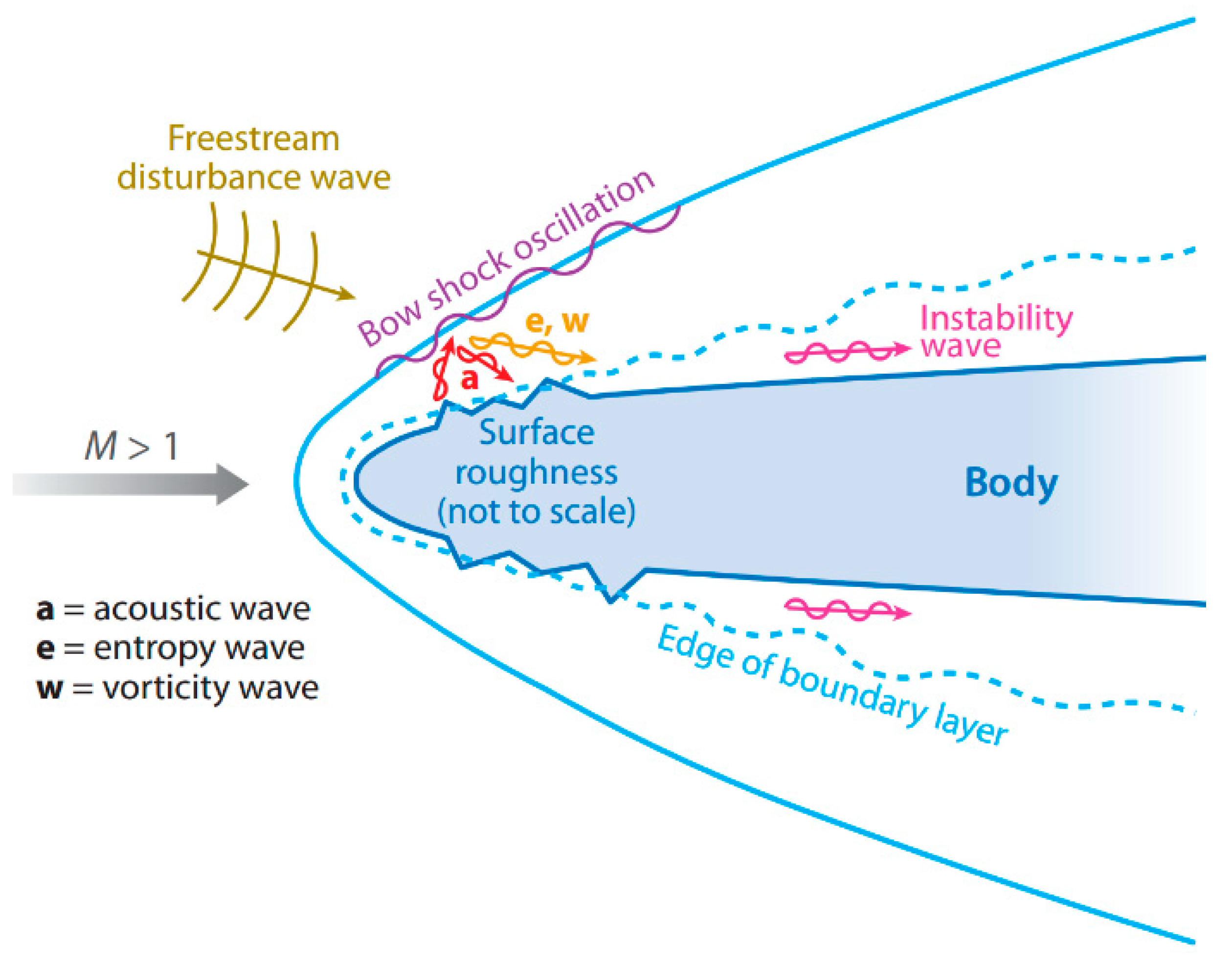

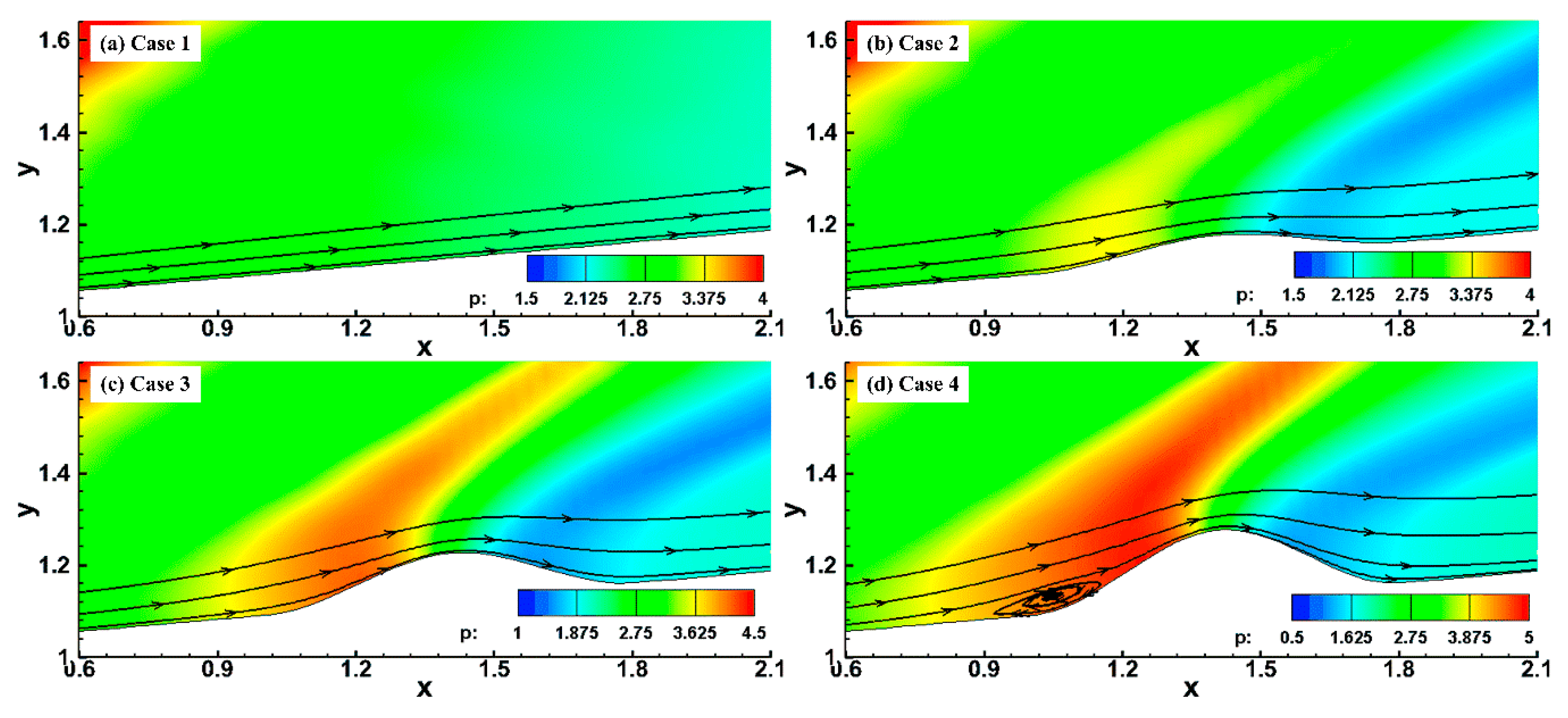
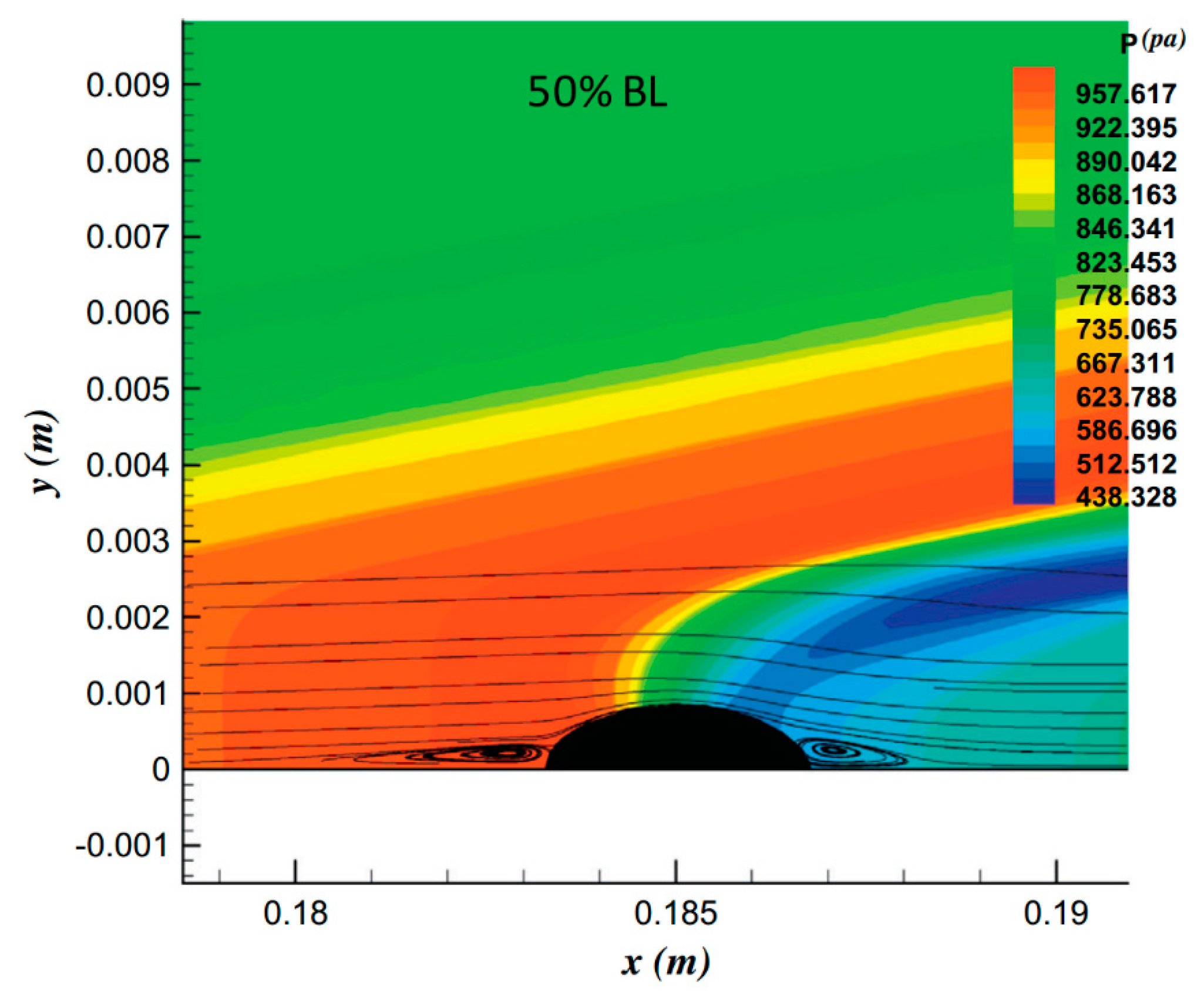
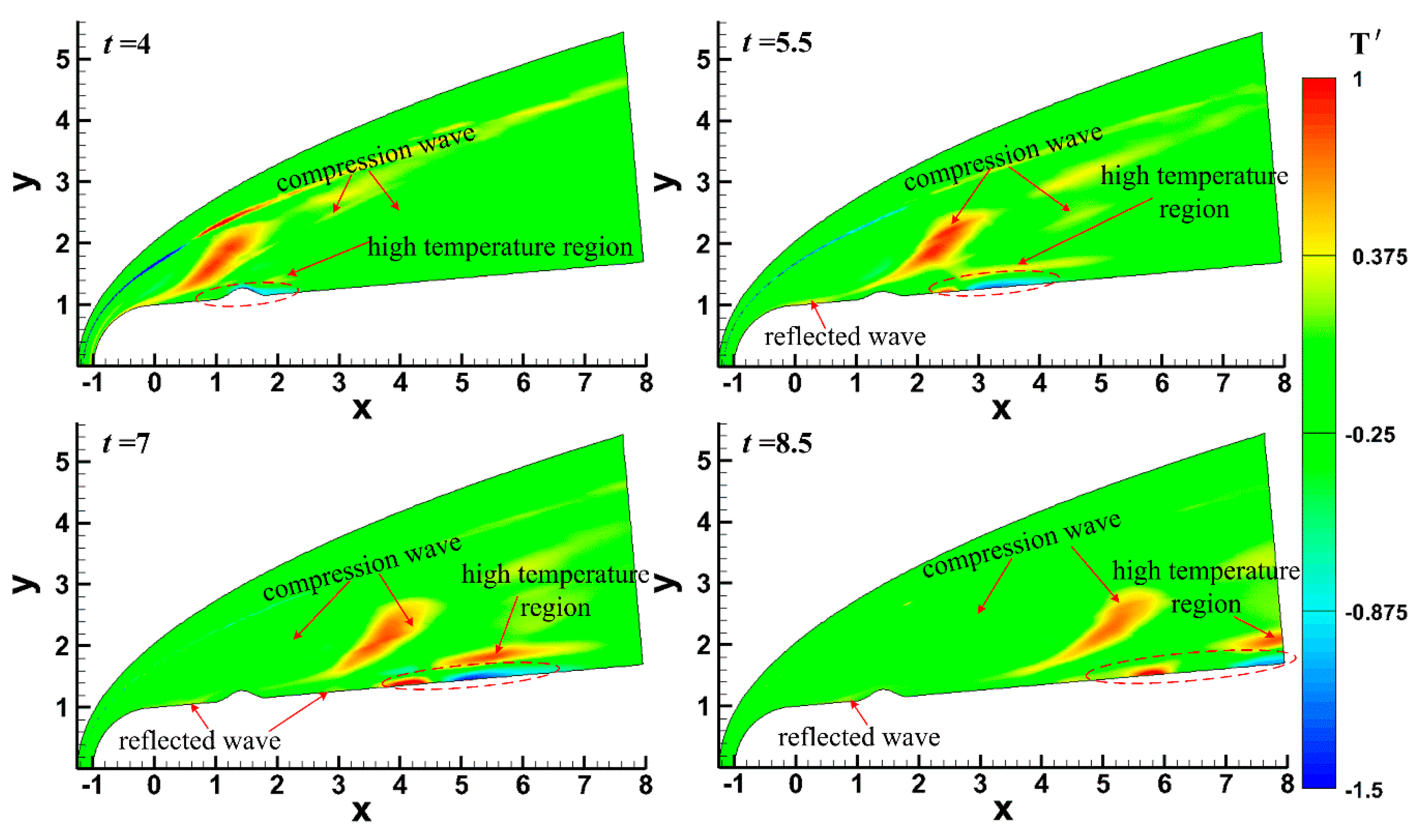

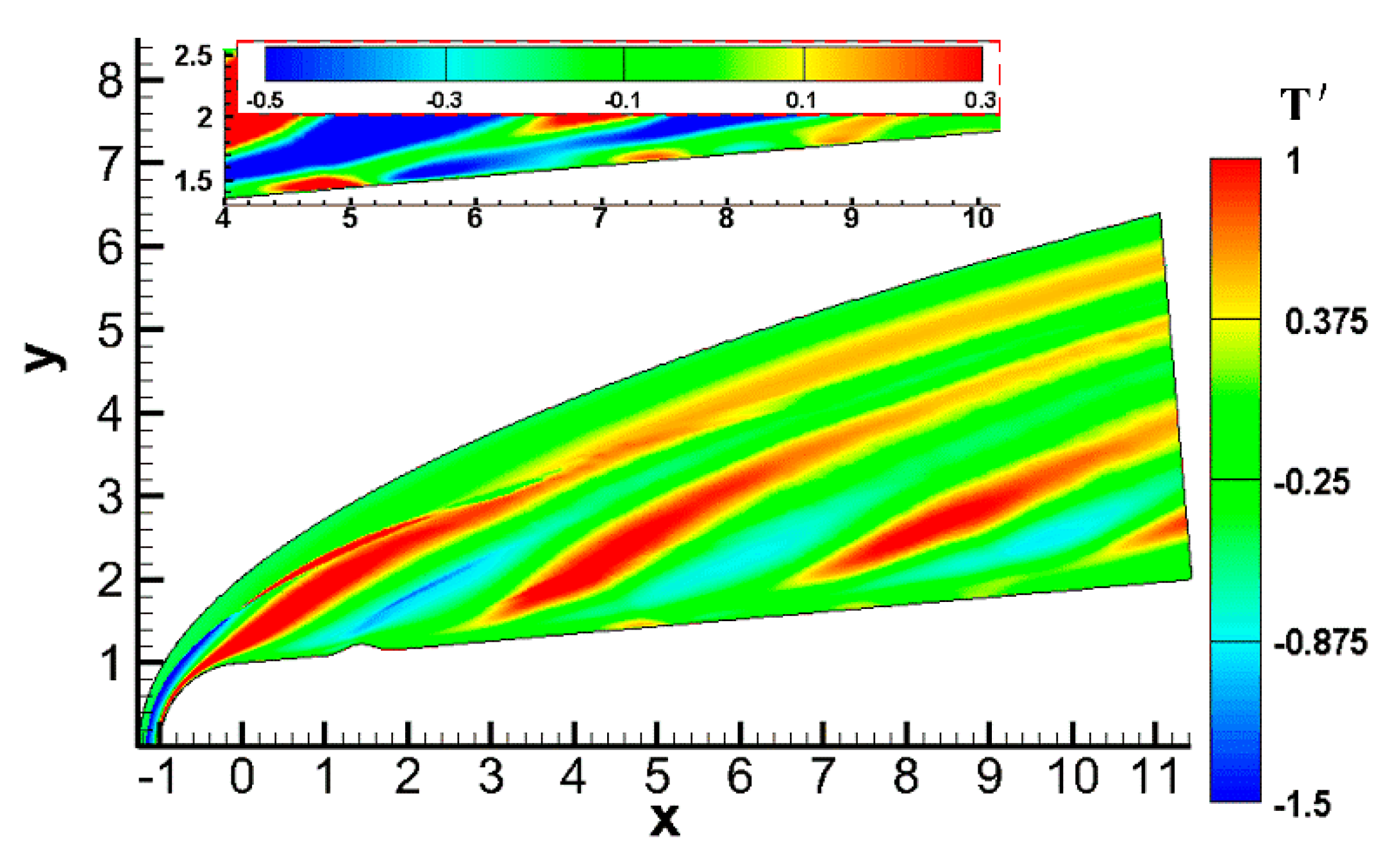


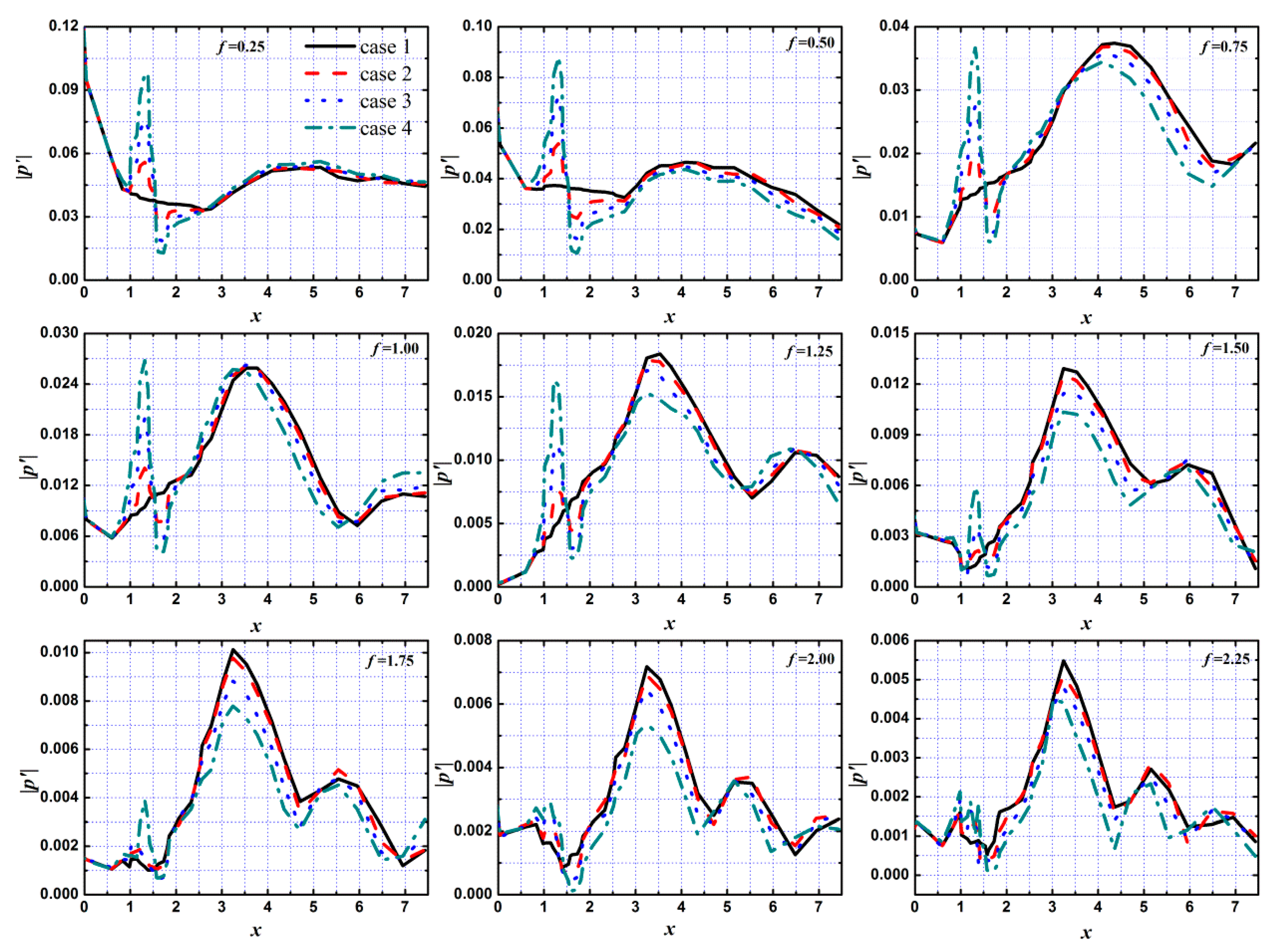
| xc | w | h | |
|---|---|---|---|
| Case 1 | 1.4071 | 0.40 | 0 |
| Case 2 | 1.4071 | 0.40 | h1 = 0.05 (25%δbl) |
| Case 3 | 1.4071 | 0.40 | h2 = 0.10 (50%δbl) |
| Case 4 | 1.4071 | 0.40 | h3 = 0.15 (75%δbl) |
© 2018 by the authors. Licensee MDPI, Basel, Switzerland. This article is an open access article distributed under the terms and conditions of the Creative Commons Attribution (CC BY) license (http://creativecommons.org/licenses/by/4.0/).
Share and Cite
Wang, Z.; Shi, M.; Tang, X.; Lv, H.; Xu, L. Effect of a Roughness Element on the Receptivity of a Hypersonic Boundary Layer over a Blunt Cone Due to Pulse Entropy Disturbance with a Single Frequency. Entropy 2018, 20, 404. https://doi.org/10.3390/e20060404
Wang Z, Shi M, Tang X, Lv H, Xu L. Effect of a Roughness Element on the Receptivity of a Hypersonic Boundary Layer over a Blunt Cone Due to Pulse Entropy Disturbance with a Single Frequency. Entropy. 2018; 20(6):404. https://doi.org/10.3390/e20060404
Chicago/Turabian StyleWang, Zhenqing, Mingfang Shi, Xiaojun Tang, Hongqing Lv, and Lidan Xu. 2018. "Effect of a Roughness Element on the Receptivity of a Hypersonic Boundary Layer over a Blunt Cone Due to Pulse Entropy Disturbance with a Single Frequency" Entropy 20, no. 6: 404. https://doi.org/10.3390/e20060404




